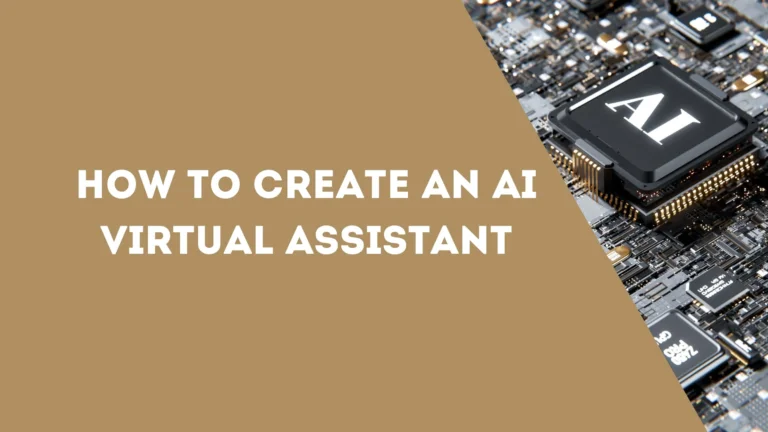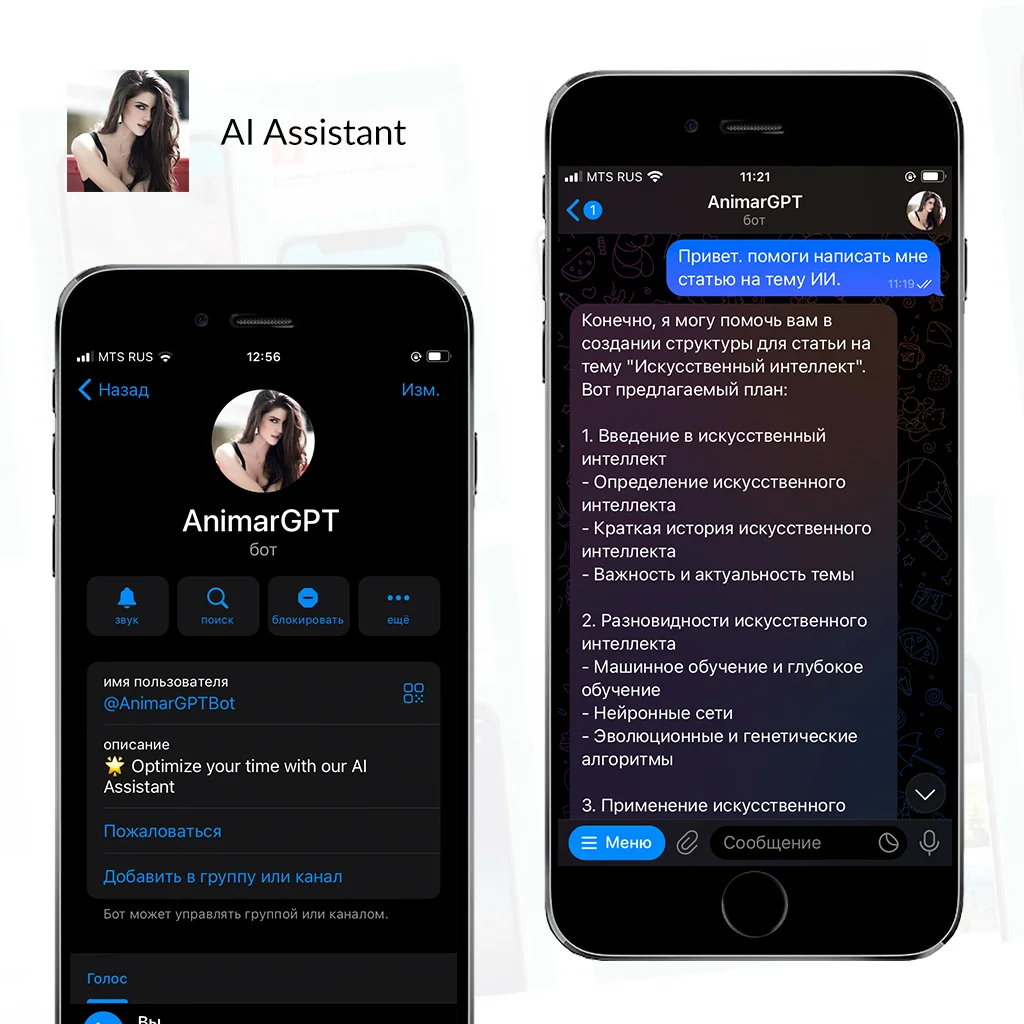How to Build Virtual Assistant in 2024
This article delves into the dynamic world of AI virtual assistants, exploring their evolution, functionalities, and the key technologies that drive them. It highlights the role of natural language processing in enhancing user interactions and discusses the future trends and challenges in the development of these intelligent virtual assistants. The article also provides insights into building your own AI assistant, emphasizing the importance of choosing the right platform and technology stack for effective development and deployment.

How to create an AI virtual assistant
Introduction
In the realm of technological innovation, AI virtual assistants stand as a pinnacle of progress, blending artificial intelligence, natural language processing, and machine learning to revolutionize how users interact with their devices. From planning appointments to controlling smart home devices, these assistants, like Google Assistant and various AI-powered virtual assistants, have become integral in our daily lives. They understand voice commands, process data, and assist in a range of tasks, making them indispensable tools in both personal and business contexts.
This article aims to build a comprehensive understanding of AI assistants, exploring their design, development, and the profound impact they have on our interaction with technology. As we delve into the world of AI assistants, we uncover the intricate processes behind their operation and the vast potential they hold in enhancing user experience and streamlining complex tasks.
Understanding AI Virtual Assistants

Defining AI Virtual Assistants
AI virtual assistants, a blend of artificial intelligence (AI) and user-centric design, are digital entities that perform tasks for users based on commands or questions. These assistants, powered by AI technology, leverage machine learning and natural language processing to understand and execute voice commands. They are designed to simplify various tasks, for example, to control smart home devices, thereby becoming an indispensable part of daily life.
Evolution of AI Assistants
The journey of AI assistants began with simple voice recognition systems and has evolved into sophisticated entities capable of understanding natural language and performing complex tasks. This evolution has been fueled by advancements in AI technology, particularly in areas like machine learning, natural language understanding, and automatic speech recognition. Over the years, these assistants have transitioned from being a novel feature to an invaluable tool integral to personal and business efficiency.
Types of AI Assistants
Google Assistant: Known for its integration in Android devices and Google Home, Google Assistant excels in processing voice queries and offering personalized assistance.
Siri: Apple’s intelligent assistant, Siri, available on iOS and macOS devices, is renowned for its voice interaction capabilities and seamless integration with Apple’s ecosystem.
Other Assistants: Besides these, there are numerous other AI virtual assistants, designed with specific functionalities to cater to different user needs. These include AI voice assistants for phone calls, AI writing assistants for content creation, and AI avatars for more interactive experiences.
AI assistants have become more than just tools; they are now key players in the realm of digital assistance, transforming how users interact with technology and manage their daily tasks. Their continuous development promises even more advanced capabilities and wider applications in various fields.
The Role of Natural Language Processing (NLP)

Understanding NLP in AI Assistants
Natural Language Processing (NLP) stands at the core of modern AI assistants, enabling them to understand and interpret human language. This AI technology, which combines computational linguistics with machine learning, allows virtual assistants to process voice commands and text messages. NLP’s role is crucial in transforming raw user input into meaningful data that AI assistants can use to perform specific tasks, from scheduling appointments to setting reminders.
Transforming Voice and Text Interactions
The integration of NLP in AI assistants like Google Assistant and various AI voice assistants has revolutionized how users interact with their devices. It has enabled these assistants to understand and respond to voice commands in a more human-like manner. This advancement is not just about recognizing speech but also about understanding the context and nuances of language, which is a significant step in artificial intelligence.
NLP has also enhanced the capabilities of AI writing assistants, making them more efficient in generating and understanding complex text. The technology’s ability to learn from user interactions means that AI assistants continually improve their understanding and responses, leading to more personalized and effective assistance. This evolution in NLP has made AI assistants an indispensable tool in managing various tasks across multiple devices, offering a seamless and intuitive user experience.
Key Technologies Behind AI Assistants

Core Technologies in AI Assistant Development
The development of AI assistants like Google Assistant and various AI-powered virtual assistants relies heavily on several key technologies:
Machine Learning: This involves AI systems learning from data to improve their performance over time. Digital learning algorithms are essential for AI assistants to understand user preferences and adapt to their behaviors.
Speech Recognition: This technology enables AI assistants to understand and process voice instructions. It plays a crucial role in facilitating hands-free interactions, from setting reminders to playing music.
Artificial Intelligence: The overarching technology that powers AI assistants, AI involves creating intelligent machines capable of performing tasks that typically require human intelligence.
The Role of AI Tools and Platforms
AI tools and platforms are instrumental in the development of virtual assistants. They provide the necessary infrastructure and frameworks for building, training, and deploying AI models. These platforms often come equipped with features like natural language generation, deep learning models, and text and speech recognition capabilities, which are vital for creating intelligent virtual assistants.
Chatbot Platforms: These are specialized in handling customer queries and automating responses, making them a key component in customer service-oriented AI assistants.
Development Platforms: Platforms like Alli AI offer tools for building more complex AI assistants capable of performing a wide range of tasks, from administrative tasks to managing social media posts.
The integration of these technologies and platforms has led to the creation of AI assistants that are not only efficient in task management but also capable of providing personalized experiences to users across various devices, including Android and iOS devices, as well as Windows operating systems.
Step-by-Step Guide to Building Your AI Assistant

1. Identifying the Purpose and Functionalities
The first step in creating an AI virtual assistant is to define its purpose and functionalities. Whether it’s a digital assistant for scheduling meetings, an AI-powered virtual assistant for handling phone calls, or a personal assistant for managing daily tasks, to create to-do lists, for example, the functionalities should align with the user’s needs. This step involves outlining key points such as:
Targeted Tasks: Determine if the assistant will handle administrative tasks, manage messaging apps, or assist in other specific areas.
User Interaction: Decide how users will interact with the virtual assistant, whether through voice commands, text inputs, or both.
2. Choosing the Right Platform or Technology Stack
Selecting an appropriate platform or technology stack is crucial. This could range from using established platforms like Alli AI to custom-building your solution. Considerations include:
Compatibility: Ensure the platform is compatible with various operating systems, such as Windows and Apple devices.
Functionality: The platform should support the functionalities you want in your AI assistant, like speech recognition for a voice assistant or text processing for an AI writing assistant.
3. Data Gathering and Processing for AI Training
Data is the lifeblood of any AI system. For an AI assistant, this involves collecting data relevant to its intended functions. This step includes:
Data Collection: Accumulate data that your AI assistant will use, such as voice samples for voice assistants or text data for AI writing assistants.
Data Processing: Clean and organize the data to make it suitable for training your AI model.
4. Fine-Tuning AI with Prompt Engineering
Prompt engineering involves designing and refining the prompts that will guide the AI assistant’s responses. This step is critical for ensuring that your AI assistant can handle a range of queries effectively. It includes:
Developing Prompts: Create prompts that cover a wide range of potential user interactions.
Testing and Refinement: Continuously test and refine these prompts based on user feedback and performance.
5. Deployment and Monitoring of the AI Assistant
Once your AI assistant is developed, the next step is deployment. This involves:
Integration: Integrate the AI assistant into the desired platform or device, such as smart speakers or digital assistant applications.
Monitoring and Updates: After deployment, monitor the assistant’s performance and make necessary updates. This could involve enhancing its ability to schedule appointments, play music, or provide expense reporting.
Throughout these steps, it’s important to keep in mind the end goal: creating an AI assistant that not only performs tasks efficiently but also enhances the user experience. By following this guide, you can build an AI assistant that is tailored to specific needs, whether it’s for personal use or as a valuable tool in a business setting.
Challenges in AI Virtual Assistant Development

Technical and Ethical Challenges
Developing AI virtual assistants involves navigating a complex landscape of technical and ethical challenges. Technical challenges include ensuring seamless integration across various platforms, such as Windows operating systems and hands-free speakers. Developers must also create intelligent virtual assistants that can understand and respond to a wide range of user commands and queries.
Ethical challenges are equally significant. They involve questions about the extent to which AI should be allowed to simulate human interactions. The development of AI avatars, for instance, raises questions about authenticity and the potential for misuse in impersonating human entities.
User Privacy and Data Security Concerns
One of the most pressing concerns in the development of AI personal assistants is user privacy and data security. As these assistants often handle sensitive personal information, ensuring the security of this data is paramount. This includes protecting against unauthorized access and ensuring compliance with data protection regulations.
Developers must also address user concerns about privacy, especially in relation to voice assistants like “Hey Google,” which are often always listening. Users need assurance that their conversations are private and that their data is used responsibly and ethically.
Overcoming Challenges with Advanced AI Technologies
To overcome these challenges, developers are increasingly turning to sophisticated AI technologies. AI-powered solutions are being developed to enhance data security and user privacy. For example, AI algorithms can be used to detect and prevent security breaches, while also ensuring that the AI personal assistant only activates when needed, thus protecting user privacy.
In addition, developers are working on creating more transparent AI systems. This involves making it clear to users when they are interacting with an AI, what data the AI is collecting, and how that data is being used. Transparency is key to building trust and ensuring the ethical use of AI virtual assistants.
In conclusion, while the development of AI virtual assistants offers immense potential, it also comes with significant challenges. Addressing these challenges requires a careful balance of innovative technology, ethical considerations, and a commitment to user privacy and data security. As the field advances, these factors will remain crucial in shaping the future of AI virtual assistants.
Future Trends and Innovations in AI Virtual Assistant Technology

Upcoming Trends in AI Virtual Assistant Development
The landscape of AI virtual assistants is rapidly evolving, driven by continuous innovations in technology. Upcoming trends include more sophisticated AI algorithms, enhanced personalization, and broader integration across platforms and devices.
Advanced AI Technologies and Machine Learning
Future virtual assistants will leverage sophisticated AI technologies and machine learning algorithms to offer more intuitive and efficient services. These technologies will enable virtual assistants to understand and predict user needs better, making them more proactive and helpful in daily tasks.
Enhancing User Experience with Voice Assistants and AI Avatars
Voice assistants are set to become more natural and conversational, thanks to improvements in natural language processing and voice command recognition. AI avatars, offering a more personalized and interactive experience, are expected to become more prevalent, especially in customer service and personal assistance.
Integration Across Platforms
AI virtual assistants will see wider integration across various platforms, including Windows operating systems, Android, and iOS. This integration will enable seamless user experiences, allowing tasks to be easily managed across multiple devices.
Evolving to Handle Complex Tasks
Future AI virtual assistants are predicted to handle more complex administrative duties and tasks. They will be capable of managing intricate scheduling, complex query resolution, and even decision-making processes. Thus they will become indispensable in both personal and professional settings.
Increasing Use in Personal and Professional Life
The use of AI virtual assistant apps is set to increase significantly in both personal and professional spheres. These assistants will become central to managing daily activities, from compiling task agendas to organizing meetings and handling communications.
The Role of NLP and Speech Recognition
Natural language processing and voice recognition technologies are key drivers in the evolution of AI assistants. Future advancements in these areas will enable assistants to understand context and subtleties in language, making interactions more natural and effective.
Transforming Industries and Everyday Life
AI virtual assistants have the potential to transform various industries by automating tasks, enhancing customer experiences, and improving efficiency. In everyday life, they will become more integrated, assisting with a wide range of activities and becoming more of a personal assistant than a tool.
In conclusion, the future of AI virtual assistant technology is bright, with advancements poised to make these assistants more intelligent, versatile, and integral to our daily lives. As they evolve, they will not only become more capable of handling complex tasks but will also offer more personalized and seamless experiences across various platforms.
Scrile’s Approach to Building AI Virtual Assistants

Introduction to Scrile’s Expertise and Services
At Scrile, we pride ourselves on our extensive experience in software development, spanning over 20 years. Our journey in this dynamic field has equipped us with profound expertise in creating cutting-edge AI virtual assistants. We understand the intricacies of developing virtual assistants that are not only efficient but also user-friendly and intelligent.
Leveraging Experience in Software Development
Our team of seasoned developers and experts utilizes our rich history in software development to build virtual assistants. We create solutions tailored to meet our clients’ specific needs. We also ensure that each virtual assistant we develop is unique and effective. Our experience covers a wide range of platforms, including Windows operating system and various mobile environments, ensuring versatility and adaptability.
Case Studies: AI Assistants Developed by Scrile

One of our notable achievements in the realm of AI is the development of an AI assistant with advanced voice command recognition capabilities. This project, which we undertook for a client targeting managers and entrepreneurs, was completed in just 21 days by a dedicated team of two specialists. This AI assistant, designed to enhance content quality through text editing and image generation, is a testament to our ability to deliver high-quality, efficient AI solutions swiftly.
Our approach to building AI virtual assistants is comprehensive. We start by understanding the unique requirements of our clients and then proceed to design and develop solutions that meet these needs. Our team designs AI-powered avatars and virtual assistants with the end-user in mind, ensuring they are not only technologically powerful but also intuitive and easy to interact with.
In addition to our custom solutions, we offer a range of pre-developed features that can be integrated into AI virtual assistants. This approach not only speeds up the development process but also ensures that we address the specific needs of each business effectively. Whether it’s handling phone calls, managing administrative tasks, or providing support through messaging apps, our AI solutions are equipped to handle a variety of tasks efficiently.
To sum up, at Scrile, we commit to pushing the boundaries of artificial intelligence technology to create virtual assistants that are not just tools but partners in our clients’ success. Our blend of experience, innovation, and client-centric approach positions us uniquely in the field of AI virtual assistant development. We continue to evolve and adapt, ensuring that our solutions remain at the forefront of technological advancements.
Conclusion

As we reflect on the journey of AI virtual assistants, their significance in our daily lives and businesses becomes increasingly evident. These intelligent virtual assistants, from voice assistants to AI avatars, have revolutionized the way we interact with technology, making our interactions more intuitive and efficient. Looking ahead, the potential for these virtual assistants is boundless, with continuous advancements shaping their capabilities. At Scrile, we are excited to be at the forefront of this evolution, designing and developing some of the best AI assistants. Our commitment to innovation ensures that we will continue to play a pivotal role in shaping the future of AI virtual assistants, making life and work more manageable and productive for everyone.
FAQ
How do I create an AI virtual assistant?
Creating an AI virtual assistant involves several steps. First, identify the specific tasks you want your virtual assistant to perform. This could range from scheduling appointments to handling voice instructions. Next, choose the right platform or technology stack that suits your needs. You can use existing AI frameworks or platforms designed for building personal assistants. Finally, customize your AI with specific functionalities, ensuring it can handle the tasks efficiently.
Can AI be a virtual assistant?
Absolutely! AI technology is the backbone of modern virtual assistants. These intelligent virtual assistants use AI to understand and process user requests. They also perform tasks, and even learn from interactions to improve over time. They assist with various tasks, making them highly versatile and valuable in both personal and professional settings.
Can I build my own AI?
Yes, you can build your own AI, especially with the numerous resources and tools available today. Building your own AI involves understanding the basics of AI technology, selecting the right tools and platforms, and programming the AI to perform tasks. It requires a combination of technical knowledge and creativity.
Can I create my own AI like Jarvis?
Creating an intelligent virtual assistant like Jarvis from Iron Man is a complex task but not impossible. It involves advanced programming skills and a deep understanding of AI technologies. While creating an AI with the same level of sophistication as Jarvis is currently beyond the reach of most individual developers, you can certainly create a simplified version that can perform certain tasks using voice commands and AI avatars.
Read also
AI Personal Assistant: Enhancing Productivity
Discover how AI personal assistants can enhance your productivity, offering features like task management, scheduling, and personalized recommendations.
AI Virtual Assistant: Top Applications
Explore the top applications of AI virtual assistants, their benefits, and how they are transforming various industries.
Character AI Alternatives with No NSFW Filter or Censorship
Find alternatives to Character AI that do not have NSFW filters or censorship, allowing for unrestricted creative expression.
Best AI Avatar Generators: Top Picks Reviewed
Discover the best AI avatar generators, comparing features, user experiences, and customization options to help you choose the right one.
OnlyFans vs. Patreon: Which Is Better?
Compare OnlyFans and Patreon to determine which platform is better for your content creation needs, including features, pricing, and user experience.